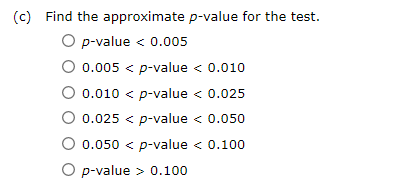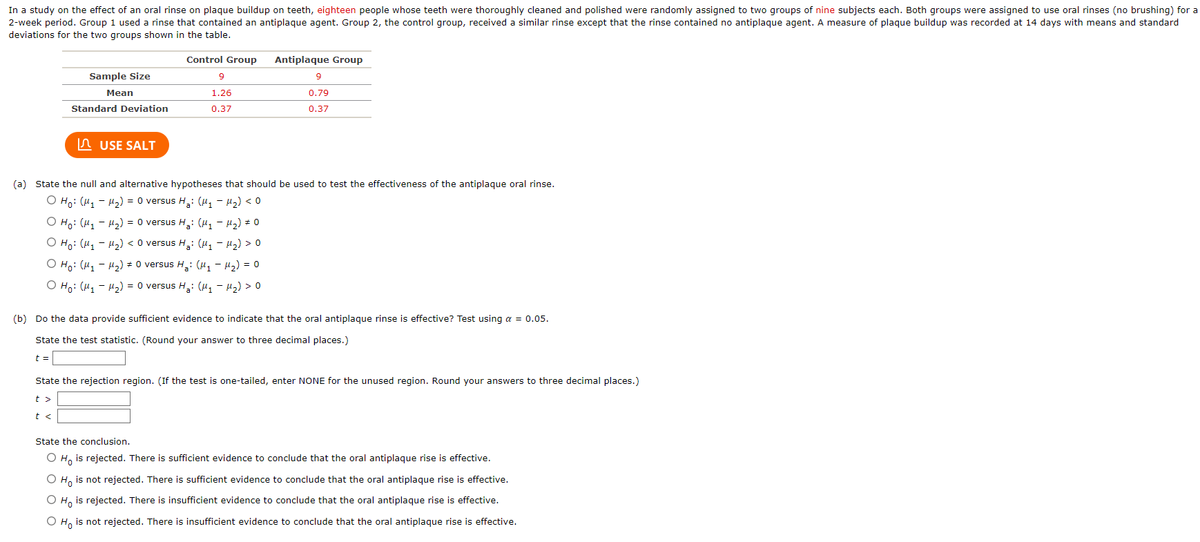In a study on the effect of an oral rinse on plaque buildup on teeth, eighteen people whose teeth were thoroughly cleaned and polished were randomly assigned to two groups of nine subjects each. Both groups were assigned to use oral rinses (no brushing) for 2-week period. Group 1 used a rinse that contained an antiplaque agent. Group 2, the control group, received a similar rinse except that the rinse contained no antiplaque agent. A measure of plaque buildup was recorded at 14 days with means and standard deviations for the two groups shown in the table. Sample Size Mean Standard Deviation USE SALT Control Group 9 1.26 0.37 Antiplaque Group 9 0.79 0.37 (a) State the null and alternative hypotheses that should Ho: (H₁-H₂) = 0 versus H₂: (H₁-H₂) <0 Ho: (H₁-H₂) = 0 versus H₂: (H₁-H₂) = 0 O Ho: (H₁-H₂) <0 versus H₂: (H₁-H₂) > 0 O Ho: (H₁-H₂) = 0 versus H₂: (H₁-H₂) = 0 Ho: (H₁-H₂) = 0 versus H₂: (₁-₂) > 0 used to test the effectiveness of the antiplaque oral rinse. (b) Do the data provide sufficient evidence indicate that the oral antiplaque rinse effective? t using a 0.05. State the test statistic. (Round your answer to three decimal places.) State the rejection region. (If the test is one-tailed, enter NONE for the unused region. Round your answers to three decimal places.) t> State the conclusion. OH is rejected. There is sufficient evidence to conclude that the oral antiplaque rise is effective. O Ho is not rejected. There is sufficient evidence to conclude that the oral antiplaque rise is effective. conclude that the oral antiplaque rise is effective. O Ho is not rejected. There is insufficient evidence to conclude that the oral antiplaque rise is effective. Ho is rejected. There is insufficient evidence
In a study on the effect of an oral rinse on plaque buildup on teeth, eighteen people whose teeth were thoroughly cleaned and polished were randomly assigned to two groups of nine subjects each. Both groups were assigned to use oral rinses (no brushing) for 2-week period. Group 1 used a rinse that contained an antiplaque agent. Group 2, the control group, received a similar rinse except that the rinse contained no antiplaque agent. A measure of plaque buildup was recorded at 14 days with means and standard deviations for the two groups shown in the table. Sample Size Mean Standard Deviation USE SALT Control Group 9 1.26 0.37 Antiplaque Group 9 0.79 0.37 (a) State the null and alternative hypotheses that should Ho: (H₁-H₂) = 0 versus H₂: (H₁-H₂) <0 Ho: (H₁-H₂) = 0 versus H₂: (H₁-H₂) = 0 O Ho: (H₁-H₂) <0 versus H₂: (H₁-H₂) > 0 O Ho: (H₁-H₂) = 0 versus H₂: (H₁-H₂) = 0 Ho: (H₁-H₂) = 0 versus H₂: (₁-₂) > 0 used to test the effectiveness of the antiplaque oral rinse. (b) Do the data provide sufficient evidence indicate that the oral antiplaque rinse effective? t using a 0.05. State the test statistic. (Round your answer to three decimal places.) State the rejection region. (If the test is one-tailed, enter NONE for the unused region. Round your answers to three decimal places.) t> State the conclusion. OH is rejected. There is sufficient evidence to conclude that the oral antiplaque rise is effective. O Ho is not rejected. There is sufficient evidence to conclude that the oral antiplaque rise is effective. conclude that the oral antiplaque rise is effective. O Ho is not rejected. There is insufficient evidence to conclude that the oral antiplaque rise is effective. Ho is rejected. There is insufficient evidence
Chapter9: Sequences, Probability And Counting Theory
Section: Chapter Questions
Problem 47RE: For the following exercises, assume two die are rolled. 47. Construct a table showing the sample...
Related questions
Question
I need help with these parts of question 5

Transcribed Image Text:(c) Find the approximate p-value for the test.
O p-value < 0.005
O 0.005 < p-value < 0.010
0.010 < p-value < 0.025
O 0.025 < p-value < 0.050
0.050 < p-value < 0.100
O p-value > 0.100

Transcribed Image Text:In a study on the effect of an oral rinse on plaque buildup on teeth, eighteen people whose teeth were thoroughly cleaned and polished were randomly assigned to two groups of nine subjects each. Both groups were assigned to use oral rinses (no brushing) for a
2-week period. Group 1 used a rinse that contained an antiplaque agent. Group 2, the control group, received a similar rinse except that the rinse contained no antiplaque agent. A measure of plaque buildup was recorded at 14 days with means and standard
deviations for the two groups shown in the table.
Control Group
9
1.26
0.37
Sample Size
Mean
Standard Deviation
USE SALT
Antiplaque Group
9
0.79
0.37
(a) State the null and alternative hypotheses that should be used to test the effectiveness of the antiplaque oral rinse.
O Ho: (M₁M₂) = 0 versus H₂: (M₁M₂) <0
O Ho: (M₁
M₂) = 0 versus H₂: (M₁ - H₂) = 0
O Ho: (M₁
M₂) < 0 versus H₂: (M₁ - H₂) > 0
O Ho: (M₁M₂) #0 versus H₂: (μ₁ −μ₂) = 0
O Ho: (M₁M₂) = 0 versus H₂: (μ₁ −μ₂) > 0
(b) Do the data provide sufficient evidence to indicate that the oral antiplaque rinse is effective? Test usi
State the test statistic. (Round your answer to three decimal places.)
t =
α = 0.05.
State the rejection region. (If the test is one-tailed, enter NONE for the unused region. Round your answers to three decimal places.)
State the conclusion.
O Ho is rejected. There is sufficient evidence to conclude that the oral antiplaque rise is effective.
O Ho is not rejected. There is sufficient evidence to conclude that the oral antiplaque rise is effective.
O Ho is rejected. There is insufficient evidence to conclude that the oral antiplaque rise is effective.
O Ho is not rejected. There is insufficient evidence to conclude that the oral antiplaque rise is effective.
Expert Solution
This question has been solved!
Explore an expertly crafted, step-by-step solution for a thorough understanding of key concepts.
Step by step
Solved in 4 steps with 7 images

Recommended textbooks for you


Glencoe Algebra 1, Student Edition, 9780079039897…
Algebra
ISBN:
9780079039897
Author:
Carter
Publisher:
McGraw Hill

College Algebra (MindTap Course List)
Algebra
ISBN:
9781305652231
Author:
R. David Gustafson, Jeff Hughes
Publisher:
Cengage Learning


Glencoe Algebra 1, Student Edition, 9780079039897…
Algebra
ISBN:
9780079039897
Author:
Carter
Publisher:
McGraw Hill

College Algebra (MindTap Course List)
Algebra
ISBN:
9781305652231
Author:
R. David Gustafson, Jeff Hughes
Publisher:
Cengage Learning

Algebra & Trigonometry with Analytic Geometry
Algebra
ISBN:
9781133382119
Author:
Swokowski
Publisher:
Cengage